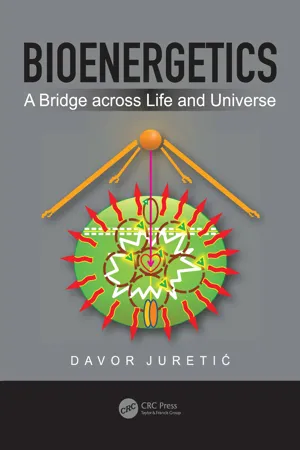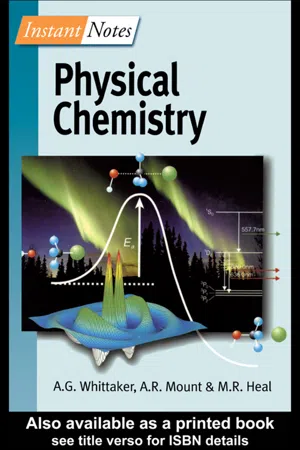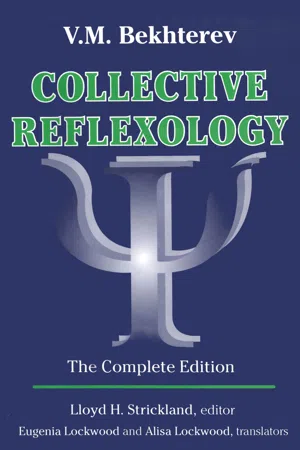Entropy Generation
Entropy generation refers to the increase in entropy within a system, often associated with the dissipation of energy and the degradation of useful work. In engineering, it is a measure of the inefficiency and irreversibility of processes, particularly in thermodynamic systems. Minimizing entropy generation is a key consideration in the design and operation of energy-efficient technologies.
7 Key excerpts on "Entropy Generation"
- eBook - ePub
Bioenergetics
A Bridge Across Life and Universe
- Davor Juretic(Author)
- 2021(Publication Date)
- CRC Press(Publisher)
...Other authors stressed that the entropy production is an essential concept in the stochastic thermodynamics pertaining to the operation of molecular machines (Seifert 2012). Regarding life-origin proposals, it is not credible that considerably simpler molecular machines for harnessing free-energy gradients in the origin-of-life period were more efficient than their present-day relatives. Much more likely situation then was that the ratio of wasted to used energy for any organic synthesis was considerably higher in that period. Thus, we must return to the same question why dissipation was crucial for the emergence of life as it is essential in the present-day bioenergetics? Is it possible that entropy production had some role in selecting the organic structures capable of increasing entropy production? The assumption underlying this question about the capability of far-from-equilibrium systems to facilitate entropy production increase in the universe opens the issue that is clearly in the realm of physics: why should the universe care about any local increase in the dissipation level? The dissipation rate cannot be the consequence of the Second Law of Thermodynamics Unfortunately, the Second Law does not say anything about how fast the system approaches the thermodynamic equilibrium. The evolution of all physical systems is coupled to the decrease of their free energy in the least time (Wang 2006, Lucia 2014). Thermodynamics is the only branch of classical physics concerned with evolution. It does not distinguish between animate and inanimate systems. The physical principle of maximum energy dispersal is equivalent to the maximal rate of entropy production with no demarcation lines to its application between animate and inanimate, incipient life, or developed living systems (Kaila and Annila 2008, Annila and Salthe 2010, Annila and Kolehmainen 2015). The origin of life must involve the dissipation of energy (Pascal et al...
- eBook - ePub
Einstein's Fridge
The Science of Fire, Ice and the Universe
- Paul Sen(Author)
- 2020(Publication Date)
- William Collins(Publisher)
...Heat flows through them as it moves from hotter to colder rooms. In each engine, some heat is turned into work – perhaps it pumps water out of a mine. The rest disperses. Eventually, the rooms’ temperatures equalise. Once the house reaches this state of maximum entropy, the engines will stop working. The heat in the house will no longer be of any use. Increasing entropy is thus a measure of the decreasing usefulness of heat. All this can seem fanciful. But the multichambered house is a way of understanding any system in which heat disperses. It is a simulacrum for the modern world. We release concentrated heat from fossil fuels, atomic nuclei, sunshine, geothermal sources, or wind. As it flows, we turn some into work that enables our homes, factories, and transport. Using engines to exploit low entropy Life, too, runs on this principle. Plants live by dispersing solar energy, animals by dissipating calories from food. ΔS >=0 rules us all. In 1865, Clausius revisited the two laws of thermodynamics that he had first stated in his paper of fifteen years prior. He updated them by employing the word energy instead of Kraft, and he added his own coinage, entropy. The laws state : 1. The energy of the universe is constant. 2. The entropy of the universe tends to a maximum. (Universe means any system that’s closed or sealed off. But because the universe we live in has nothing beyond it, it is true that its energy cannot change and its entropy tends to rise. More intuitively, the second law can be stated: the entropy of any closed system tends to increase.) These two lapidary statements are a testament to the human intellect and imagination. They are a scientific milestone every bit as significant as Newton’s laws of motion, which were published two centuries earlier. Since 1865, when Clausius published these principles, they have been at the forefront of physics, helping humans to better understand everything from atoms to living cells to black holes...
- eBook - ePub
- Gavin Whittaker, Andy Mount, Matthew Heal(Authors)
- 2000(Publication Date)
- Taylor & Francis(Publisher)
...If the energy is transferred reversibly to or from a system, it must be possible to reverse the direction of the transfer through an infinitesimal change in the conditions. In practice, this requires that the energy be transferred infinitely slowly. An irreversible process results from energy transfer which is not transferred under these conditions. Thermodynamic definition of entropy Entropy is a thermodynamic property of a system, denoted as S. It is a state function and is defined in terms of entropy changes rather than its absolute value. For a reversible process at constant temperature, the change in entropy, d S, is given by d S =d q rev / T. For an irreversible process, d S >d q / T. Statistical defination of entropy In addition to the thermodynamic definition of entropy, it is also possible to refer to entropy in statistical terms. For any system, the entropy is given by S = k B ln (W), where W is the number of possible configurations of the system. This definition allows the entropy to be understood as a measure of the disorder in a system. The third law of thermodynamics The third law of thermodynamics states that the entropy of a perfectly crystalline solid at the absolute zero of temperature is zero. The entropy has a measurable absolute value for a system, in contrast to the enthalpy and internal energy. There is no requirement for standard entropies of formation to be defined, as the absolute values of entropy may be used in all calculations. Related topics The first law (B1) Entropy and change (B5) Enthalpy (B2) Free energy (B6) Thermochemistry (B3) Statistical thermodynamics (G8) Reversible and irreversible processes Any process involving the transfer of energy from one body to another may take place either reversibly or irreversibly. In a reversible process, energy is transferred in such a way as to ensure that at any point in the process the transfer er may be reversed by an infinitesimally small change in the conditions...
- eBook - ePub
The Myth of Progress
Toward a Sustainable Future
- Tom Wessels(Author)
- 2013(Publication Date)
- University Press of New England(Publisher)
...This is where our paradigm of progress collides with the second law of thermodynamics. From a global perspective, if we continue to use more energy, we will continue to increase entropy within the biosphere unless we can bring in new energy from outside the biosphere to counter that entropy. But where would that new, extra-terrestrial energy come from? Since the level of solar gain isn’t seriously increasing, as we transform more and more energy within the biosphere we create greater entropy. There is no way around this. To replace ecosystem functions compromised by entropy, water purification for example, means consuming even more energy, resulting in further entropy. This becomes a positive feedback loop that just makes things worse. We can’t progress under a scenario that produces more entropy in an attempt to fix entropic problems. The second law dictates that our current march toward progress will eventually collapse under its own entropic weight. Our only solution to counter increasing biospheric entropy is to reduce global energy consumption. Renewable energy resources can definitely help, since they create a lot less entropy than nonrenewable forms of energy, but they have some entropic costs, too. How much entropy results from the mining, refining, and shipping of materials to build solar collectors, electrical wires, and batteries? How much then results from the manufacturing of these things, packing them for transport, the shipping to distribution centers, and finally to stores? Within each of these activities are numerous energy transformations. The wisest approach is to conserve energy as much as possible through the development of our most efficient technologies, and to reduce and eventually cease frivolous, unneeded energy consumption. Most of the energy consumption that we are responsible for is hidden from view in the extraction of materials, manufacturing processes, and transportation...
- eBook - ePub
- Wolfgang Hofkirchner, Wolfgang Hofkirchner(Authors)
- 2013(Publication Date)
- Routledge(Publisher)
...17: The Overall Pattern of the Evolution of Information in Dissipative, Material Systems STANLEY N. SALTHE DISORDER AND DISORGANIZATION I have argued for the reality of a second law of infodynamics as a generalization of the second law of thermodynamics (Salthe, 1993). This generalization from the physical law, made by many others previously, is based in Boltzmann’s interpretation of entropy as disorder. Disorder is more general than physical heat, and can be applied even to linguistic phenomena. From this point of view heat is seen as energy configurations unavailable for use because they are scattered or dispersed away from the configuration of a palpable gradient at the scale of the system in question. Such a gradient is, from the point of view of a system that can degrade it, orderly. Now, this definition of entropy as disorder depends on the concept of scale. If we have a pile of coal in a delivery system, it can be used to run a steam engine. But if it becomes dispersed indeterminately over many miles, that availability is lost. Yet single pieces of this coal might still be used to boil a pan of water. But if a piece of this coal is smashed to powder, it is lost to that use as well, but could now drive chemical reactions, at a yet much smaller scale. Or, if we go back to the steam engine, as the energy of the steam passes as heat into the atmosphere, it can no longer be reused in the same way, but its heating of the atmosphere might drive chemical reactions at, again, a much smaller scale. Disorder, we must note, is definitely a subjective concept, which physical heat was not supposed to be. But many positivist thinkers over the years have doubted that physical entropy was itself sufficiently objective to be part of the canon of physics...
- eBook - ePub
- Dov M. Gabbay, Paul Thagard, John Woods, Dov M. Gabbay, Paul Thagard, John Woods(Authors)
- 2011(Publication Date)
- North Holland(Publisher)
...All accepted the principle of the conservation of energy as the first law of thermodynamics. But most sought to supplement that law with another concept/function that accounted for energy dissipation or degradation. It is the availability or effectiveness of energy, not energy itself, that is lost in irreversible processes. Thus, for example, William Thomson, co-founder of the second law, never used the concept of entropy and rarely referred to it. He preferred to describe irreversibility in terms of energy dissipation, which he found more easily visualizable [1874]. He defined a function called the motivity that decreases in irreversible change [1879; 1898]. Others employed similar concepts. Wald spoke of the Wirkungsfähigkeit of energy and of this being devalued [1889, 103-105], Ostwald wrote about Bewegungsenergie being lost (which for him had nothing to do with the second law of thermodynamics; see [ [Deltete, 2008] and [Deltete, 2010] ]; Helmholtz referred to free and bound energy [ 1882-1883 ]; and G.N. Lewis to fugacity [1901] and activity [1907], both properties of energy. Finally, a third reason for the neglect of entropy is that it was often concealed in other, more useful (and apparently more basic) functions, even by those who stressed its importance. Thus, for example, Gibbs employed the function (14) where H = U + pV is what is now called the enthalpy; and Planck made essential use of the function (15) As the authors cited in the introduction explained the situation: To Planck, Duhem, and the few other specialists who mastered the mathematically complex field, entropy was indeed the central concept, but almost none of their equations used entropy explicitly. Advanced thermodynamics became based on thermodynamic functions and chemical potentials. These acquired a life of their own, and few theoretical chemists made direct use of entropy in their calculations. [ Kragh and Weininger, 1996, 101; also 108] 6...
- eBook - ePub
Collective Reflexology
The Complete Edition
- V. M. Bekhterev(Author)
- 2017(Publication Date)
- Routledge(Publisher)
...10 The Law of Energy Dissipation or Entropy As is known, the so-called second principle of hydrodynamics, according to which it is accepted that energy strives towards dissipation or towards the transition from uneven concentration to even distribution, has been established as an immutable law of physics since 1824, the time of Sadi Carnot. This law was later presented in a more precise fashion by Klausius in Germany and by Thomson in England. Such transition of energy from uneven to even distribution always occurs directly, while a transition in the opposite direction requires preparatory work, i.e., the expenditure of other forms of energy. In other words, as expressed by Professor Khvol'son, transformation possesses "a kind of direction." For example, the performance of work releases a corresponding amount of heat; however, when heat is transformed back into work only a fraction of its energy goes to the execution of useful work while the rest, to an extent depending on the situation, is wasted. Thus, when a rock falls to the ground it loses kinetic energy, at the same time developing heat which cannot be transformed into kinetic energy again. This basic law of physics, which can likewise be proved true in chemistry—for example, in irreversible reactions—is unquestionably applicable to organic nature, since all organisms are, essentially, carriers of stored energy that strives to be disseminated, naturally shifting into one form of mechanical work or another and being transformed into heat and other more simple forms of energy during the processes of decay. The support of life itself, i.e., the nutrition of an organism, cannot occur without a certain amount of work...






